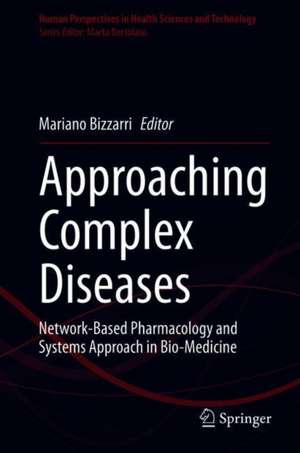Approaching Complex Diseases: Network-Based Pharmacology and Systems Approach in Bio-Medicine: Human Perspectives in Health Sciences and Technology, cartea 2
Editat de Mariano Bizzarrien Limba Engleză Hardback – 18 apr 2020
| Toate formatele și edițiile | Preț | Express |
|---|---|---|
| Paperback (1) | 1010.07 lei 38-44 zile | |
| Springer International Publishing – 18 apr 2021 | 1010.07 lei 38-44 zile | |
| Hardback (1) | 1110.32 lei 3-5 săpt. | |
| Springer International Publishing – 18 apr 2020 | 1110.32 lei 3-5 săpt. |
Preț: 1110.32 lei
Preț vechi: 1168.76 lei
-5% Nou
Puncte Express: 1665
Preț estimativ în valută:
212.53€ • 230.93$ • 178.64£
212.53€ • 230.93$ • 178.64£
Carte disponibilă
Livrare economică 31 martie-14 aprilie
Preluare comenzi: 021 569.72.76
Specificații
ISBN-13: 9783030328566
ISBN-10: 3030328562
Pagini: 483
Ilustrații: XVI, 483 p. 49 illus., 41 illus. in color.
Dimensiuni: 155 x 235 mm
Greutate: 0.82 kg
Ediția:1st ed. 2020
Editura: Springer International Publishing
Colecția Springer
Seria Human Perspectives in Health Sciences and Technology
Locul publicării:Cham, Switzerland
ISBN-10: 3030328562
Pagini: 483
Ilustrații: XVI, 483 p. 49 illus., 41 illus. in color.
Dimensiuni: 155 x 235 mm
Greutate: 0.82 kg
Ediția:1st ed. 2020
Editura: Springer International Publishing
Colecția Springer
Seria Human Perspectives in Health Sciences and Technology
Locul publicării:Cham, Switzerland
Cuprins
Chapter 1. Revisiting the concept of human disease (Mariano Bizzarri, Mirko Minini, and Noemi Monti).- Chapter 2. Dynamical aspects of pharmacokinetic/pharmacodynamics and quantitative systems pharmacology models (Ioannis Loisios-Konstantinidis, Panteleimon D. Mavroudis, Panos Macheras).- Chapter 3. The efficiency of multi-target drugs: a network approach (Lucas N. Alberca, Alan Talevi).- Chapter 4. Mining Complex Biomedical Literature for Actionable Knowledge on Rare Diseases (Vinicius M. Alvesa, Stephen J. Capuzzia, Nancy Baker, Eugene N. Muratov, Alexander Trospsha, and Anthony J. Hickey).- Chapter 5. Big Data, Personalized Medicine and Network Pharmacology: beyond the current paradigms (Alessandro Giuliani and Virginia Todde).- Chapter 6. Epigenetic Control Using Small Molecules in Cancer (Tomohiro Kozako, Yukihiro Itoh, Shinichiro Honda, Takayoshi Suzuki).- Chapter 7. Multiscale Modelling of Cancer: Micro-, Meso- and Macro-scales of Growth and Spread (Mark AJ Chaplain).- Chapter 8. Precision Oncology vs Phenotypic approaches in the management of cancer: a case for the postmitotic state (Armando Aranda-Anzaldo and Myrna A.R. Dent).- Chapter 9. Migrastatics - anti-metastatic drugs targeting cancer cell invasion (Aneta Gandalovičová , Daniel Rosel , Jan Brábek).- Chapter 10. Critical steps in Epithelial-Mesenchymal transition as target for cancer treatment (Evgeny V. Denisov, Mohit Kumar Jolly, Vitaly P. Shubin, Alexey S. Tsukanov, Nadezhda V. Cherdyntseva).- Chapter 11. Targeting the tumor-associated macrophages for ‘normalizing’ cancer (Julia Kzhyshkowska).- Chapter 12. Tumor Reversion induced by embryo and oocyte extracts (Sara Proietti, Andrea Pensotti and Alessandra Cucina).- Chapter 13. Trabectedin, a drug acting on both cancer cells and the tumor microenvironment (Paola Allavena, Manuela Liguori, Cristina Belgiovine).- Chapter 14. Advances in Characterizing Recently-identified Molecular Actions of Melatonin: Clinical Implications (Russel J. Reiter, Ramaswamy Sharma, Sergio A. Rosales-Corral, Ana Coto-Montes, Jose Antonio Boga, Jerry Vriend).- Chapter 15. Multitarget activities of Inositol and Inositol Hexakisphosphate (Ivana Vucenik).- Chapter 16. Integration of Phytochemicals and Phytotherapy into Cancer Precision Medicine (Nadire Özenver and Thomas Efferth).- Chapter 17. Synergistic Effects of Chinese Herbal Medicine and Biological Networks (Deep Jyoti Bhuyan, Saumya Perera1, Kirandeep Kaur, Muhammad A. Alsherbiny, Mitchell Low, Sai-Wang Seto, Chun-Guang Li, Xian Zhou).- Chapter 18. Medicinal herbs: its therapeutic use in obstetrics and gynaecology (Irene Orbe, Daniel Paz, Leyre Pejenaute, Andrea Puente, Laura Diaz de Alda, Sandra Yague, Iñaki Lete).- Chapter 19. Overcoming Antibiotic Resistance: New Perspectives (Matteo Bassetti, Elda Righi).
Notă biografică
Mariano Bizzarri PhD, M.D., is Associate Professor of Clinical Pathology in the Department of Experimental Medicine at University Sapienza, Rome (Italy). He was appointed as member of the Italian Space Agency (ASI) Scientific Committee in 2005 and he was elected President of that Committee in 2011-2014. He is a co-founder of the Italian Society for Space Biomedicine and Biochemistry (2006). Head of the Interdepartmental Systems Biology Center and member of the Space Research Interdepartmental Center of the University La Sapienza (CRAS). He is the Editor in Chief of the international journal ORGANISMS. He has authored hundreds of scientific and philosophical essays, as well as of dozen of scientific books, among which Systems Biology (Springer protocols, 2017).
Textul de pe ultima copertă
This volume – for pharmacologists, systems biologists, philosophers and historians of medicine – points to investigate new avenues in pharmacology research, by providing a full assessment of the premises underlying a radical shift in the pharmacology paradigm. The pharmaceutical industry is currently facing unparalleled challenges in developing innovative drugs. While drug-developing scientists in the 1990s mostly welcomed the transformation into a target-based approach, two decades of experience shows that this model is failing to boost both drug discovery and efficiency. Selected targets were often not druggable and with poor disease linkage, leading to either high toxicity or poor efficacy. Therefore, a profound rethinking of the current paradigm is needed. Advances in systems biology are revealing a phenotypic robustness and a network structure that strongly suggest that exquisitely selective compounds, compared with multitarget drugs, may exhibit lower than desired clinical efficacy. This appreciation of the role of polypharmacology has significant implications for tackling the two major sources of attrition in drug development, efficacy and toxicity. Integrating network biology and polypharmacology holds the promise of expanding the current opportunity space for druggable targets.
Caracteristici
The first book to systematically cover the issue of how to integrate network biology, systems biology and polypharmacology The only book dealing with the proposal of a paradigm shift in drug discovery focused on the network pharmacology Brings together a group of top scholars on the much-debated issue of Systems-oriented drug design






